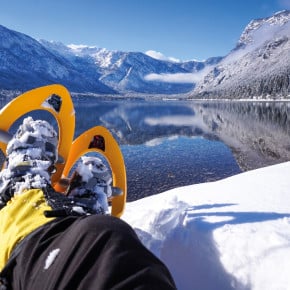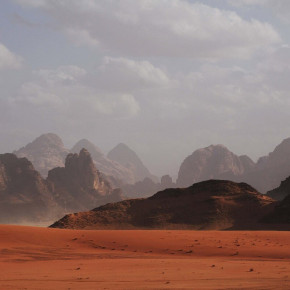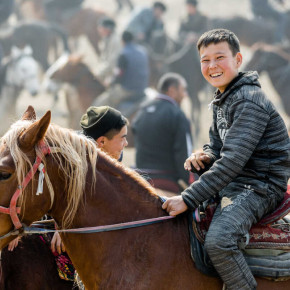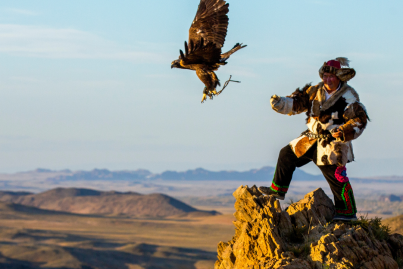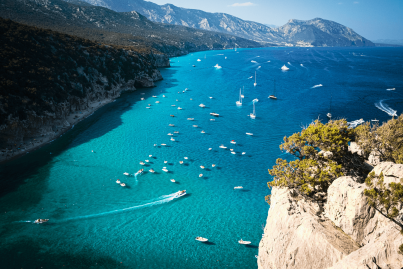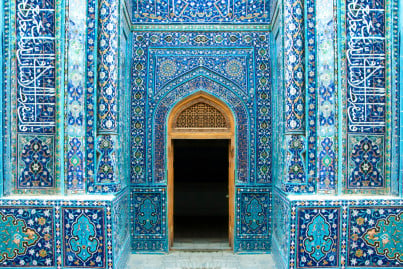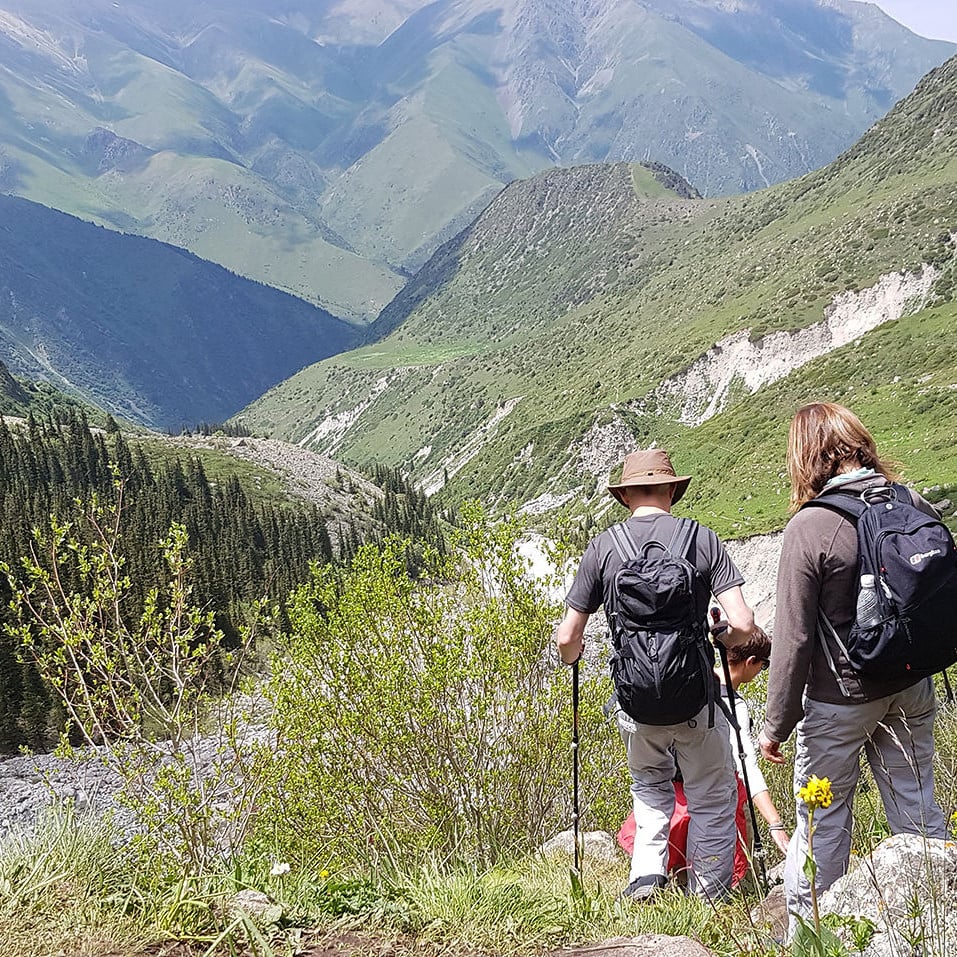"می نوش و به ماه بنگرو به تمام تمدن هایی که دیده است فکر کن"
رباعیات عمرخیام
Drink wine and look at the moon and think of all the civilisations the moon has seen passing by.
– Omar Khayyám, The Rubaiyat
My good friends Dom and Aida were getting married in Dubai so I flew back from the UK for the wedding. Half the congregation on Dom’s side were primarily British, and all of the other half on Aida’s side were Iranian. Aida’s cousin, Alireza, a dentist in Tehran, and I hit it off immediately. There is a picture of us in some Dubai beach bar with Alireza on my shoulders. By coincidence we are both wearing green shorts and a grey T-shirt. Alireza and the family invited myself and some of Dom’s (and my) friends Daf and Rob to visit them in Iran to go skiing, and we gladly accepted.
An amusing anecdote is that when I first flew into Iran for this holiday, I only had a £5 note in my pocket. No one had told me that international banks don’t work there and Alireza and Aida had to pay for my entire ski holiday and the duration of my stay in Tehran, until I was able to reimburse them upon my return to Dubai. We were welcomed into their homes like old friends. Alireza’s gregarious personality ensures he is the principal music DJ amongst his friends when they throw parties. I dubbed him the ‘DJ Dentist’ which he found very amusing, and back in London I had this epithet engraved onto a silver money clip which I sent to Tehran as a thank you for his hospitality. I like to do my part for international relations.
The Shah's Palace
We visited the palace of the Last Shah of Iran, Mohammad Reza Pahlavi. My first thought upon entering was: ‘I bet this is what it feels like to shoot craps at the Monte Carlo casino in Baku’. The palace grounds are in the very north of Tehran, where the pollution isn’t so bad and the mountains peek through the winter trees. All that remains of the many toppled monuments of the Shah are two giant bronze boots sticking out of the ground near the long concrete steps leading up to the ugly modern building. Gaudy French Rococo furniture, much of it mahogany, languished upon exquisite hand-stitched Persian rugs. The jarring contrast between East and West makes everything feel out of place beneath the outrageous cut glass chandeliers. There are priceless ill-fitting pieces of furniture from all over the world; gifts from Foreign Secretaries, oilmen, importers – anyone who wanted something.
Frescos of ancient Persian heroes adorn high circular ceilings with tigers and bows and arrows. There is a lot of marble. The effect is hotchpotch, wasteful, opulent, grotesque. I liked it. Celebrated war correspondent Robert Fisk recalls an anecdote when he went to dinner with a famous society lady in Tehran who was rumoured to be one of the last Shah’s last mistresses. Whenever the Shah wished to make love to a woman, she would be admitted via a side door of the palace to spend a few hours in one of the more discreet salons, and upon leaving she would be presented with a Labrador puppy, as a token of the King of King’s affection. Just as he was concluding the dinner, Fisk was almost knocked down by an enthusiastic fully-grown golden Labrador, which burst upon him from the kitchen.
Snowboarding in the Alborz Mountains
The artificial twinkling of the cut glass of the Shah’s palace, however dazzling, was a mere foretaste of the majesty of the sun-drenched white-capped peaks of the Alborz Mountains. Rising up to the north of the capital Tehran, the high powder glistened with a bright white flashing beauty. I thought of when the protagonist dreams he is flying towards The Snows of Kilimanjaro in Hemingway’s short story. My tiredness slipped away from me and I flew down as fast as I have ever gone on my rented snowboard, feeling close to the mountain. We had taken the high lift that had only just opened after a few days’ closure, revealing the untouched powdery snow, with only the thinnest of icy membranes on its surface, whipped up by the wind.
The view from the top of the lift’s exit point led across numerous snowy peaks to the perfectly symmetrical white form of Mount Damavand far in the distance. A potentially active stratovolcano, at 5600m it is the highest peak in Iran, and indeed the highest volcano in Asia. Unexpectedly the front edge of my snowboard dug in to what must have been a mogul under the surface, and I was flipped straight up and forward (I instinctively tucked my head down), bounced off my back – my momentum carrying my legs above me in an arc – whence I landed neatly in an upright position and continued downwards amidst a great scattering of lumps, flakes and crystals.
I could hear my friends whooping high above at my good fortune and, adrenaline really going now, I rolled from toe to heel in long lines to carve through the spray as a surfer picks his line through the best contours of a perfectly glassy wave. We joked about it afterwards down in the canteen below as we blew on the tops of our too-hot cups of coffee. As we bought these, we gestured to the waiter to write down the price as we spoke no Farsi. He obligingly did so, but in Farsi, at which the whole place erupted in hoots of derision and laughter from his colleagues. He went the colour of beetroot but laughed it off eventually.
Assassins
Daf and Rob returned to the UK, and Dom and Aida to Dubai, but I chose to stay on and, contacting a local tour operator in Tehran that Aida used to work for, I employed a guide to hike to the fabled Assassins’ castle of Alamut, that I had read about in Freya Stark’s The Valleys of the Assassins: and Other Persian Travels. I was staying in Alireza’s opulent apartment and, as is common in Iran, his parents lived in the apartment above. Upon hearing of my intentions, Alireza’s father commented (in Farsi) that I knew my history.
After the Arabs had invaded the Aryan peoples of Persia under the banner of Islam, a new sect of the religion, known as the Ismailis, created strongholds of resistance to the Sunni majority in the high castles of the Alborz Mountains. This region boasts many heroes and stories; the most famous of which is Hassan-i Sabbah, the feared leader of the dreaded Assassins in the 11th Century. The word ‘Assassin’, first brought to Europe by the Christian Crusaders, is a corruption of ‘Hashshashin’ – the infamous garden where Hassan would bring his followers to bend their minds to his will. Plying them with hashish, he would allow them the pleasures of many women and sweetmeats, persuading them that they were in paradise.
Once removed from the garden, they would be told that they could only re-enter should they do his bidding, and willingly they were sent to murder Sunni Arab dignitaries, including the then Prime Minister of Persia. Hassan and his Assassins became the most feared rebels of the age. Hassan’s castle Alamut, or ‘Eagle’s Nest’, sits high up upon a strange dreamlike formation of volcanic black rock, which diagonally cuts up into the sky in thick lines of strata. It is a place of fore- boding. Standing upon the foundations of the castle, which cling to the thin summit of the mountain, I surveyed the valley beneath me.
To the left a huge expanse of snow and ice rose up in over- whelming proportions. Below, flat metal roofs of smallholdings reflected the silver gold of the sun, which also bounced off from the river, cloud, cedar trees and everything else, hurting my eyes. Somewhere on my right a flag was fluttering. The air was fresh, the horizon long. I could smell ice in my nostrils. ‘Now,’ I heard myself think, ‘this is somewhere.’
On the way back to Tehran I had stayed at my guide Hussain’s family house. It was large and slightly run down. His mother suffered from mental health problems but was a most gracious host nevertheless, and we lounged in their vast carpeted living room eating from platters of fruit and sweetmeats. The room had faded yet beautiful embroidered rugs hanging from the walls alongside numerous family photographs and paintings. We slept Persian style which meant simply on the thickly carpeted floor of the living room on heavy mattresses with numerous duvets and blankets with a heater blasting in the centre of the room, and it was very cozy. In the morning I awoke to see Hussain bending over me. There was a silver tray holding two steaming glass cups of tea on the table. “You were sleeping so heavily I thought you were dead,” he said innocently.
Saudi Arabia
A few months later, I had just been refused entry onto a flight into Jeddah, the closest international airport to the holy city of Mecca in Saudi Arabia, from Dubai. I was on a freelance business trip producing a trade and renewable energy event in The Kingdom. It was 8am and I had just stepped off a connecting flight from London. I was tired. It was August, ten days before the Hajj begins; the annual religious holiday when over two million Muslims from across the world make the pilgrimage to Mecca where the Prophet Muhammad was born and lived for the first 52 years of his life.
The Hajj is the largest annual gathering of people in the world. Muslims walk seven times around the Kaaba, a cube- shaped building and the most sacred site in Islam: Bayt Allah, or House of God. I had a normal Saudi tourist visa (it had taken me five months to get the necessary invitation letter from inside The Kingdom to even apply for this) but the airline refused me entry because I didn’t have a special ‘Hajj Visa’. In the airline office my enacted whining/displays of outrage were completely ineffective and despite myself not being a Muslim, and them having already sold me a ticket, I realised it was just not going to happen. I bought another ticket to Riyadh, the capital, for the following day. On the plane the atmosphere was already different from the multicultural melting pot that is Dubai. There were quite a few Western-looking businessmen but no Western women. The rest of the passengers were Saudis.
The Saudi women were all dressed in black burkas, the men in white dish-dash with either a large flowing white, or a red and white chequered headscarf, secured with black cord. The air smelled of camphor. From the TV screens and speakers a prayer from the Koran resonated, one that the Prophet Muhammad used to say before embarking on a journey, the gold Arabic script flowing across a video flying over clouds and a bright blue sky. I spent a day in Riyadh and a day in Dammam, a city on the east coast near Bahrain, before returning to Dubai. It was 45 degrees outside and the heat hit you like a furnace. It is an austere place yet I always find the local people extremely friendly, welcoming and helpful. Their mosques are built with a very understated style of architecture, a manifestation of Wahhabism, their stricter form of Islam.
You drive past endless desert; there are a lot of fast-food outlets; you meet American oilmen; you drink a lot of tea; people smoke in the public lavatories; you sweat through all your clothes; the women are covered from head to foot, very rarely revealing their faces, so you only catch glimpses of their flickering eyes. I spent two days in Dubai doing some work, then flew with Dom and Aida again to Tehran. We stayed at Aida’s mother’s large, stylishly decorated house, in a quieter quarter of the city. Tehran has a population of 15 million and although the traffic and pollution can be appalling, it has a great atmosphere: vibrant, chic, fun and completely removed from the rather stifling hard-line ambiance I had experienced only a few days previously.
Back in Tehran
Leafy tree-lined streets and opulent marble-fronted apartment buildings abound, with trendy restaurants and coffee shops on every corner in the richer northern neighbourhoods. Tehran was a welcome relief after a stressful and hectic week, and as I was now an ‘old friend’ for many of Aida’s friends and family, a rather exhausting round of family parties ensued with everyone shouting over everyone else in Farsi across huge dinner tables laden with opulent platters of food, loud music blaring and dancing into the early morning hours.
Iranian women are extremely beautiful and although in public they are required to wear an abaya partially covering their heads, in the capital especially this is nearly always pushed as far back as possible, revealing their full hair and face often adorned with make-up and bright lipstick. At private parties in the houses of friends or family, women remove their abayas to reveal the most modern fashions (if they are rich of course). It is common for women to work but they still have many disadvantages to navigate in public society.
The men are handsome and some of them have excellent physiques as wrestling is the national sport. Sometimes you see a man walking down the street with arms like actual tree- trunks. If you meet an Iranian man for the first time there is a 50% chance his name will be Alireza. Both men and women have only very dark hair and olive skin from their Persian heritage. Some of the men have fantastically thick but well-trimmed beards. Iranians are not Arabs; they are descendants of the Persians and speak Farsi rather than Arabic. It is a completely different language (with a surprising amount of French and Spanish influence), although is written using the Arabic script.
A little Persian history
The Persians, after creating one of the greatest empires the world has ever seen [553-330 bc] were conquered by the Arabs over a period of 20 years from the first attack in 633 ad, when Islam exploded out of Saudi Arabia after the death of the Prophet Muhammad. In bloody conquest, the Islamic Caliphates, under various dynasties, established an empire that ruled from India to Spain. The name ‘Iran’ only began to be used after the conquest of the Arabs, and derives from the word ‘Aryan’, denoting the Persians’ ancestors’ origin from the northern steppes of Central Asia and Russia.
Another fundamental difference is in the nature of their religion. Although Muslim, Iranians are Shiites, compared with the Saudis and indeed the majority of the Islamic world, who are Sunnis. The division in their religious beliefs stems from a division in the line of succession of the leaders of the faith after the Prophet Muhammad died. The Shiites believe that his true successor was Muhammad’s nephew Ali who also married Muhammad’s daughter Fatima, and the ensuing line of ‘Imams’ that followed from him until the 12th Imam ‘Al-Mahdi’ who disappeared after persecution by the Sunnis, and whom they believe will one day return again alongside Jesus Christ (also a prophet in Islam) to lead the Muslims in rightful governance.
The Sunnis on the other hand believe that Abu Bakr, close companion and through his daughter Aisha, the father-in-law of the Prophet Muhammad, was the true inheritor of the faith, and the ensuing line of ‘Caliphs’ that ruled after him. There are other myriad differences between the two sects, as well as many different offshoots and styles of Islam, but this is a basic explanation. They are all Muslims however, and Iranians and other Shiites will still make the Hajj pilgrimage to Mecca in predominantly Sunni Saudi Arabia.
We slept in in the mornings then would drive into the city to upmarket chelo kebab restaurants for lunch where it is good to be seen. The food is delicious, but the concentration of lamb and beef in huge quantities alongside buttered rice and thick yoghurt is so heavy, that often we had to return home for after- noon naps before heading out to see our friends again in the evenings. Dom and I decided to drive down to Isfahan for the sightseeing. The five-hour drive down from the capital passed through unbelievably dry, desolate and barren desert; a shock to the system after the mountain-enclosed, well-irrigated leafy streets of Tehran. It was difficult to believe that we were in the same country.
Isfahan
Yet as soon as we entered the suburbs of Isfahan, as if by a miracle trees reappeared everywhere in the shady, well-irrigated oasis of civilisation. Along the streets, as across the rest of the country, black and white photos of ‘the martyrs’ hung from lampposts. These are the men from local neighbourhoods who fought and died in the bloody Iran/Iraq war of 1980-1988, when Saddam Hussein invaded the western border of Iran, resulting in a catastrophic loss of life.
Isfahan, although the second largest city in the country, in no way compares with the frenetic energy of Tehran. It is much more subdued with more parks and far less traffic. The seat of the Safavid dynasty [1301-1736 ad] after the capital came down from the north, this era is considered one of the most important in the country’s history, and the city’s palaces and mosques are still the epicenter around which its daily life revolves.
We checked into a fancy hotel in the centre of town that in ancient times was also a Caravanserai [a rest-house for travelling camel caravans]. This was revamped into its current opulent, glittering manifestation under the rule of Mohammad Reza Pahlavi, the last Shah of Iran until his overthrow by the Iranian Revolution in 1979. The main area of Isfahan, Naqsh-e Jahan Square, is 560 metres long by 160 metres wide, and is surrounded on all sides by two-story identically constructed buildings forming a perimeter wall. Before a fountain was built in the middle of this great space, nobles used to watch polo matches from the raised dais of Ali Qapu Palace balcony.
The square was and remains the centre of community life. The mosque, palace, hammam, bazaar, food halls, and ped- dlers’ stalls all convene together to service the requirements of the people. Red-helmeted soldiers used to patrol the square, keeping the peace in the name of the king. European painters in the 17th Century were invited to come and paint frescos on the walls to demonstrate the ruler’s treaties with the outside world. The great Shah Mosque, situated on the southern end of the square, is the jewel in the crown of the country. It is mainly blue in its outer mosaic colourings, and very large with two immensely tall minarets stretching up to the heavens, denoting its adherence to the Shia form of Islam, as Sunni mosques will have either one or four minarets.
The mosque contains four smaller mosques that enclose a communal courtyard where men would bring their camels to sell and trade, discuss religion and taxes. The dexterity of the design combined with the simplicity and scale of the architecture is impossible to relate. But they inspire the finer internal melodies hidden in the heart of a person, all-too rarely teased forth by the routines of daily life, and like a fine conductor, induces your soul to rise up and sing with joy to realise the heights of beauty which humanity is capable of attaining.
A mullah, seemingly of some importance, dressed in a light grey cloak with a dazzlingly white turban welcomed us and was very diplomatic in asking where we were from and explaining the teachings they do in the religious schools. These are found in the low-rise buildings that face the verdant gardens adjoin- ing the main courtyard. He thanked us for coming to Iran and said that all people, no matter their religion or race, were welcome to come and visit the mosque, and he encouraged us to bring others in the future. I know a humble-brag or a fake smile when I see one, but he meant it and I liked him.
Outside the square, the royal palaces are situated between shady gardens and fountains. Features include: ceilings of cut glass; soaring wooden roof supports carved in the same style as the ancient stone pillars of Persepolis; the first mirror ever brought to the country at great expense from Venice; a draughty palace hall covered in frescos of various battles with Ottomans and diplomatic treaties with Uzbeks; a bed in which Queen Elizabeth II of England once slept but was so uncomfortable that Shah Reza Pahlavi ordered the hotel in which we were staying to be created; summer porches; winter porches with fireplaces; latticework windows; frescos of birds, flowers and Islamic patterns.
Yazd
Dom caught a plane back to Dubai but again I stayed on alone and caught a bus the next day heading east, back into the barren desolation of arid nothingness, towards the city of Yazd. Yazd is quite remarkable because it doesn’t seem natural for a city to thrive in the middle of a desert, yet it is one of the oldest towns on earth, with an estimated 2000 years of permanent human settlement. Set in the dead centre of Iran, it is the natural converging point of the country’s trade. It is surrounded by a ring of sun-scorched mountains, with complex under- ground irrigation systems that keep the city alive throughout the blisteringly hot summers, when temperatures can reach up to 48 degrees.
It is famous for its windcatchers [badgir in Farsi]. A medi- eval form of air conditioning prevalent across the Middle East, these are a high, latticed chimney-like structure raised above a house or building to catch draughts of wind that are pulled down to cool the rooms below. They are very attractive to look at and many modern buildings across the region still incorporate them in their design. When I lived in Dubai for a couple of years, my modern apartment building was designed in this style. The badgir rise above the low-rise mud walls of which many of the buildings are still constructed. They are interspersed across the city by elegant turquoise-tiled domes and very tall, turquoise-tiled minarets.
At night I walked along the cooling streets to Masjid Jameh, the largest of the Mosques. I never feel threatened in Iran, day or night, and am less suspicious when first approached by men or women on the street, compared with some other countries, due to the Iranian people’s natural inquisitiveness, and legendary hospitality. I listened while a mullah expounded on something in Farsi through a microphone, sat underneath a huge arched edifice bathed in white light. The men all sat around on red carpets drinking small cups of chai whilst the women sat outside in the courtyard on a raised dais, all in black abayas. An expansive looking man waved me over and insisted I share some saffron and pistachio cake with him.
The following day was baking hot and I lazed about. I went to the Zoroastrian fire temple but it was still closed so I sat opposite in a café working on my laptop for a couple of hours. Zoroastrianism is the ancient religion of Persia and when the Arabs invaded, Yazd was one of the last strongholds of its believers, although many of its rituals and symbols have permeated into their religion today. At the great mosque in Isfahan for example, right where the King would pray towards Mecca, there is a beautiful green mosaic of the ‘Tree of Life’, which stems from Zoroastrian mythology. The Zoroastrians regard fire as a symbol of purity, and in the temple in a huge brass urn, pieces of almond and apricot wood are burning, maintaining a flame that has been kept alive for the last 1524 years. The temple was built by the Last Shah and so is relatively modern, but pleasingly understated.
Persepolis
Atop some simple pillars is the Zoroastrian symbol of a Persian man with an Achaemenid-era distinctive pointed beard, two large wings either side of him (one representing good, one bad) and a circle at the bottom, representing the consequences of one’s actions. I went in to look at the flame then came back out and sat on a stone step in the blazing sunshine, the heat pounding away on my skin. I continued my solo journey to the bazaars of Shiraz, the region from where the grape vines of the famous wine originate from, and from there the ancient Persian capital of Persepolis. I will not attempt to wax-lyrical about the latter, because nothing I can say will do it justice. It is like trying to describe the Parthenon in Athens; all the clever prose in the world can’t convey the feeling you have when presented with living history.
Alexander the Great burned Persepolis to the ground in 330 bc, destroying the Achaemenid Persian Empire following his victory over the Persian Emperor Darius III at the Battle of Gaugamela. There are varying accounts, but it is said that this was instigated by one of the Macedonian (Greek) courtesans, as payback for the burning of Athens by the Achaemenid Army of Xerxes generations before in 480 bc. Ironically its destruction preserved a huge amount of the exquisite limestone carvings of its foundations and pillars, which were buried for thousands of years beneath the ash and the sands of the surrounding desert.
By the early fifth century bc the Achaemenid Persian Empire ruled an estimated 44% of the human population on earth. The carvings at Persepolis portray representatives of the conquered vassal states bringing offerings to the Persian Emperors, not cowering as slaves, but as dignitaries dressed in their distinctive traditional clothing. A Persian carrying the staff of office with a dagger at his waist holds the hand of the leader of the Armenians; Assyrians follow with sheep; the Lydians carry vases, bowls, two metal armlets and are followed by two men with a two-horse chariot; the Scythians, marked by their pointed hats, bring a horse, and clothing including a pair of Scythian trousers; the Parthians, a two humped camel; the Ionian Greeks bring spices and ointments.
Hundreds of small hand-held clay tablets were unearthed on the site, many documenting trades in silver, others messages about everyday life, shopping lists, love letters. The cuneiform writings look like text messages on a mobile phone from 2500 years ago. Some of the pillars of the once great halls still stand to this day, each supporting the huge carved bulk of twin bulls at the top. All had to pass through the Gate of All Nations, protected by flanking carvings of the great mythological crea- tures Lamassus; bulls with the head of a bearded man, which originate from Babylonia to ward off evil. Truly, the interwoven impressions of Iran fill the soul until it overflows.
This chapter is taken from Wax & Gold: Journeys in Ethiopia & other roads less travelledby Sam McManus

